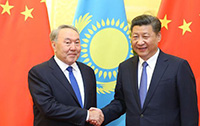A Beijing garden stands witness to Sino-French relations
By Han Bingbin (China Daily) Updated: 2015-05-28 08:00He was also an active host of salons, where he brought together Chinese and French luminaries to discuss cultural issues and current affairs. His frequent guests then included the late French diplomat Saint-John Perse (1887-1975), author Victor Segalen (1878-1919) and Chinese educator Li Shizeng (1881-1973), whose legendary lives are detailed in the documentary.
Perse was sent to China to quell public disputes after France's occupation of the Laoxikai district in Tianjin in 1916. He later gained access to upper-class Chinese society because of his secret relationship with late Qing Dynasty (1644-1911) princess Yu Rong-ling (1889-1973).
But his time in China ended when China had a falling out with Western governments at the 1919 Paris Peace Conference.
Segalen, who won the Nobel Prize in literature in 1960, embarked on an adventure with Bussiere senior to Mongolia and also completed writing his poem, Anabase, secretly in Beijing's Western Hills.
The author, who once had access to the Chinese court, left after the Qing Dynasty was overthrown following the Wuchang Uprising in 1911. He was then inspired by Chinese steles and created poems that were written from the emperor's point of view.
His works such as Steles, Rene Leys and Fils du Ciel (Son of Heaven) are considered classics in French literature.
Li was one of the earliest Chinese to have studied in France. After returning to China, he initiated the work-study movement, which helped more than 1,000 Chinese youngsters study in France in the years after his first visit. The list included late Chinese leaders Zhou Enlai and Deng Xiaoping.
Throughout his life, Li maintained close connections with governments in France, even at local levels. He even rented an old castle in Lyon, where he founded the Sino-French University.
"There's much new knowledge in this documentary. It will supplement people's understanding of the exchanges between China and France," says Zhang Tongdao, a professor of documentary studies at Beijing Normal University.
Related:




